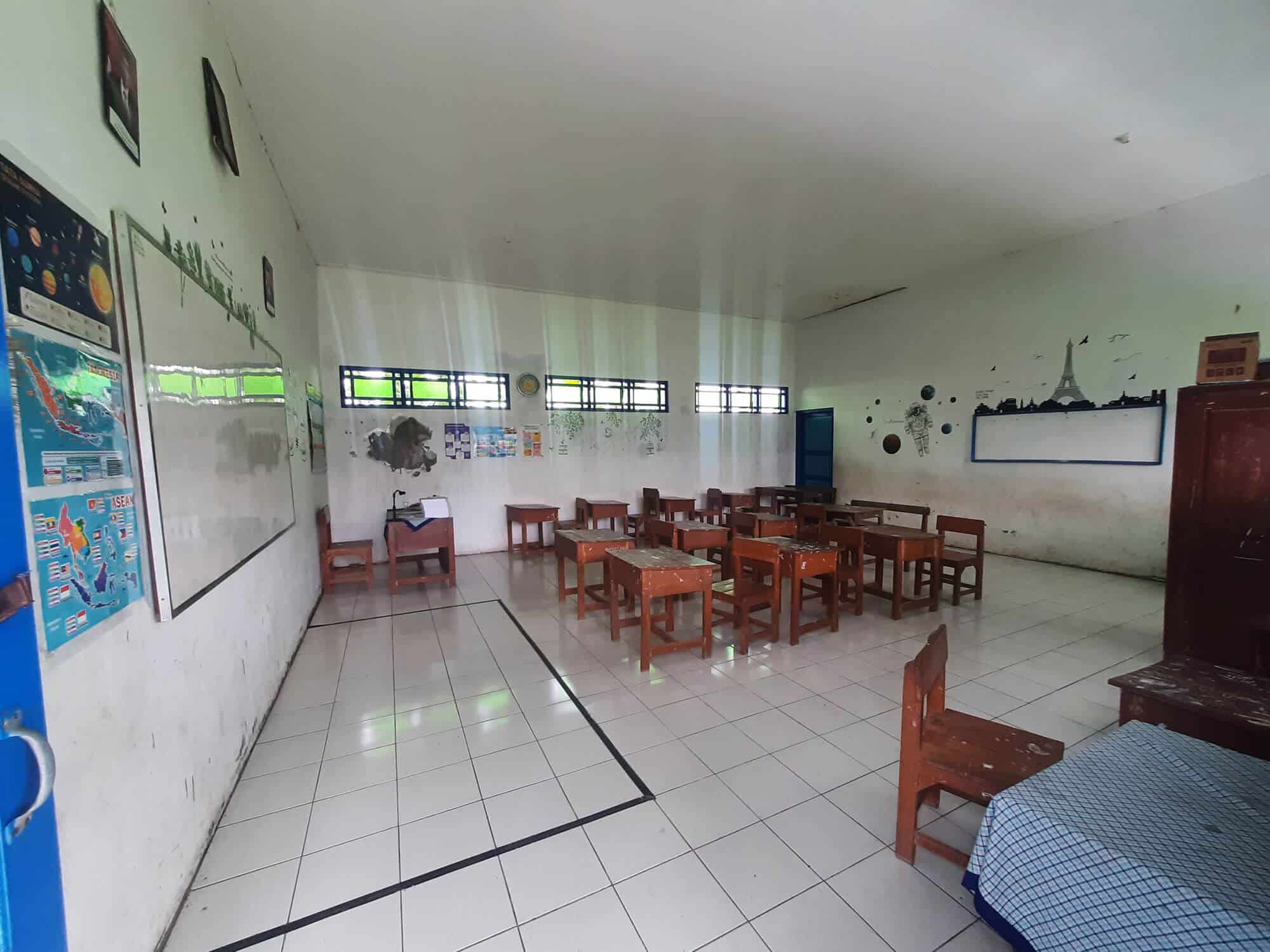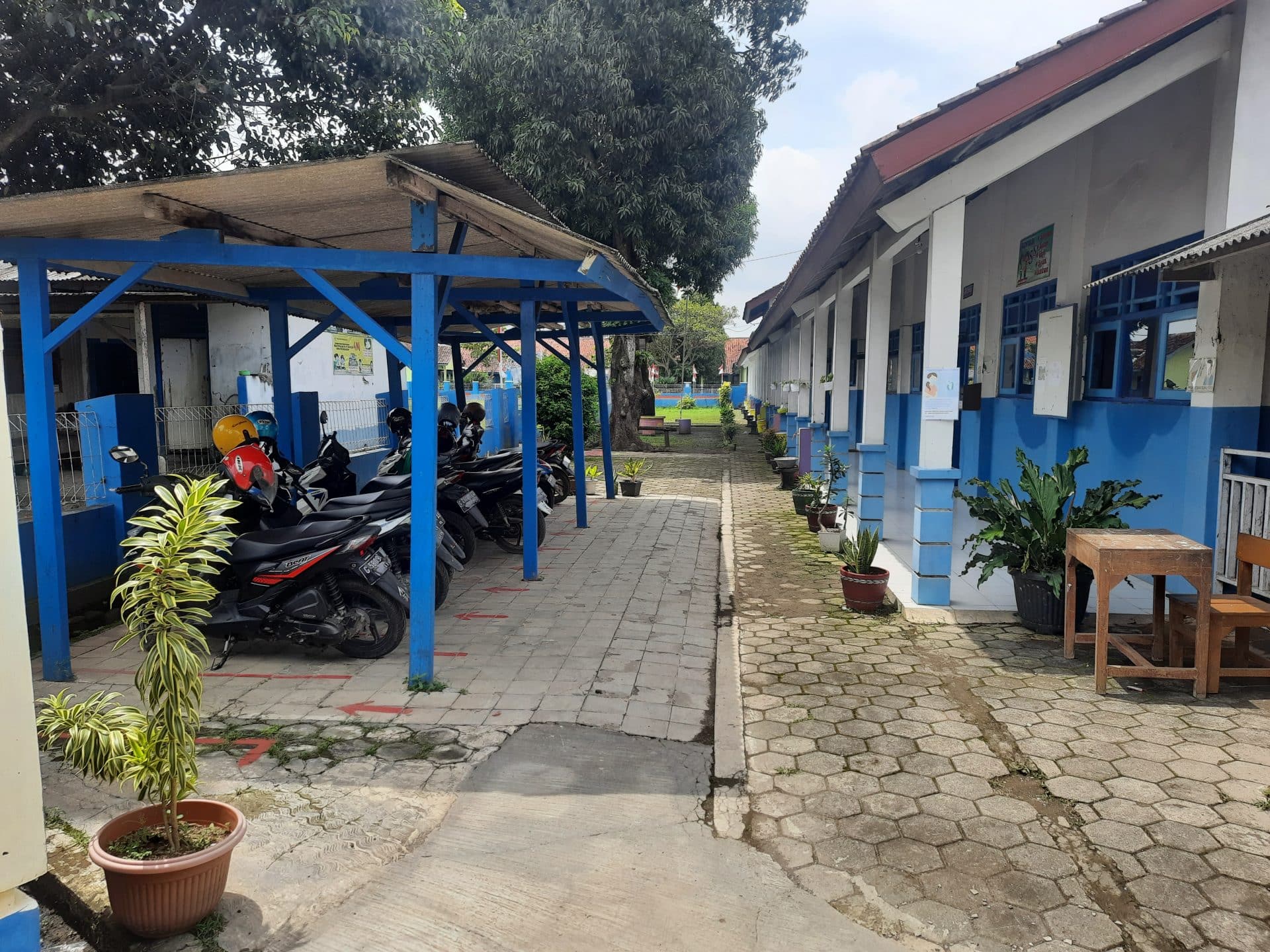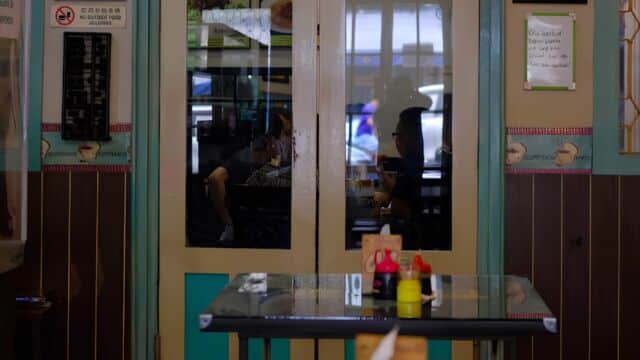Online Learning In The Javanese Countryside Isn’t As Easy As Turning On Zoom
Photo by Edotz Herjunot
A school | 2,000 words | Translated from Bahasa Indonesia by Dan Benjamin
The school where I teach is in a small village on the outskirts of Pemalang, a city of around 1.5 million people in north-central Java. The road I take to get there, while asphalted, is only around three metres wide, pothole-riddled, and flanked left and right by rice-fields. At least when travelling by motorbike to the school each morning I can enjoy the cool fresh morning air. Seeing the green of the rice always makes me want to breathe that air in deeply.
I like to deliberately slow my bike down so I can greet or just smile at the villagers, sitting around drinking cups of hot tea before going to work the fields – straightaway my smiles get returned.
The school isn’t big – the building itself is long and narrow, its entrance via the side. If you step in, you’ll immediately see the staffroom, then the line of classrooms, from Grade One to Grade Six. There’s no library, no canteen, no student bathroom. If kids want a toilet they have to use the one in the security guard’s post.
After more than four years teaching at an elite private school in Pemalang, I decided to move to a public elementary school on the city’s outer edge. It’s not easy, moving schools. You’ve got to adapt to a new environment, new people, new habits, and new students. Let alone when you do it during all-online teaching because of Covid-19.
Unfortunately, meeting new students at this school wasn’t as easy as turning on my laptop, asking them to access a Zoom meeting, then getting their names one-by-one.
I asked the other teachers how the online teaching system was working. Most said they were relying only on WhatsApp groups. While the kids studied from home, the other teachers and I still had to come to school, and from there open our books, look over the day’s instruction material, then write out the learning tasks in a WhatsApp chat. After that… well, after that there wasn’t much to do whatsoever, except wait for the children to finish their work.
‘Rifky, what’s four times four?’
The kid looked immediately surprised, then instinctively began to move his fingers – as if he was actually, genuinely counting. I waited, but Rifky did not follow this action with any other. His fingers, though, kept moving and moving – like a man of faith counting his charitable acts.
I used spare moments to talk more to the other teachers. Our tables faced each other.
“Pak Edot, the fact is, if you teach here you have to adjust to the kids’ situations. We all want to do online learning with Zoom Meetings, Google Meet and all of that. But, yeah, I mean… a lot of the kids don’t really know how, and then many of them come from backgrounds and families that aren’t affluent. Even when we send tasks via WhatsApp groups, sometimes there are kids who don’t know because they don’t have mobile data’.
Bu Afifah, one of the teachers. I just nodded.
Whenever the kids finished an assignment, they took a photo of it, then sent it to the relevant teacher. I thought about how ineffective it all was. Just handing out the material, with no teacher explanation or supervision, likely meant many kids didn’t even read it, and simply copy-pasted answers from Google.
In my first weeks teaching, these activities quickly turned monotonous. I arrived at school, sat in the office, opened a textbook, then sent messages to a WhatsApp group. The school, which should have been so alive with children’s voices, was silent. When I looked into the classroom I ought to have been teaching in, I was taken aback. The floor, tabes and chairs were covered in dust. In a corner dry leaves were scattered, presumably blown in through the air vent.

Most parents of the kids at this school are farmers. Others are farm workers, tending fields owned by others. For them, they’re grateful just to have their kids enrolled at school. They likely aren’t overly concerned about whether their children are receiving assignments from their teachers, whether their children are completing those assignments, or whether their children have mastered the material. For these parents, the main goal is simply a school-leavers certificate.
One mother came to the school to collect her child’s homework. “I apologise, Pak, for only coming now. It’s true sometimes I don’t pay much attention to the kids’ schoolwork. Please understand, Pak… I’m a farmer, I can’t always get my head around these assignments that come in on WhatsApp’. The woman in front of me spoke in a casual tone. She was dressed very simply: a red T-shirt, faded; a long black skirt, visibly dirty; a hijab with a flower motif, tied so loosely it suggested hurriedness. Looking at her, I knew this woman had come to school immediately before heading out into the fields.
‘It’s no problem, Bu – just ask every day whether there’s an assignment or not. Usually kids, if they’re not asked or reminded, they forget’.
The woman began to go into more details about her child, who was fed up with online learning. At home every day, the kid just watched TV or played on the phone – after waking up late. This mother couldn’t ensure her child rose early, because she had to leave to work in the fields.
***
So my first meeting with my students was on WhatsApp. All I did was send my photo, then chit-chat.
‘Assalamualaikum, good morning students,’ I wrote. ‘Pleased to meet you. My name is Edot, you can call me Pak Edot. I’m a new teacher at this school, and I’ll be your homeroom teacher. Hopefully we can work together well…’
But only three or four kids replied.
‘Walaikumsalam yeah Pak’
‘Nice to meet you Pak Edot’
‘Yo, Pak’.
The rest were silent. By the afternoon, my other students still hadn’t replied. Even in those few scattered responses that I had received, I noticed the kids had forgotten to introduce themselves. I hadn’t learnt the names of the children who had greeted me.
I tried checking their nicknames in their WhatsApp profiles – it didn’t help much. Mostly they used cheesy nicknames like ‘unimportant person’, or ‘Princess Syalala’, or just a series of emojis. A lot of them made their profile photos their favourite anime characters, or – this did make me laugh – one kid had uploaded a photo of Bob Marley. These were the sort of miniscule hints of the childrens’ individual personalities that I was able to glean from WhatsApp.
Without doubt, an utterly unmemorable first meeting.
The kid’s enthusiasm level when completing assignments was pretty disheartening too. Out of 27 kids in grade six, on average only 10 to 15 handed in work ontime. The rest? Who knew when they were planning to do it. Simply asking for their assignments was like pulling teeth: I felt like a debt-collector approaching the overextended.
One day I enquired about the homework of one student, which was three days late. My WhatsApp messages were being ignored: read, but never replied to. Finally I decided to phone him.
After quite some time – the fourth ring – a voice came on the line.
‘Hello, Assalamualaikum… it’s Pak Edot here, this is Bowo’s number, right?’
‘Hello, Walaikumsalam… Yeah Pak Edot, this is Bowo. How’s it going Pak?’
‘Bowo, I want to ask you, you still haven’t done your homework, why?’
‘Oh yeah Pak – well, from yesterday I wanted to do it, but I don’t have a pen, Pak’.
‘Wow… Well, that’s a tough situation, not having a pen’. Like that, I pretended to sympathise.
‘So because of that, Pak, I couldn’t do the work’.
‘Bowo, around your house there really isn’t anybody selling pens? Even if not, surely you can search for one somewhere. Borrow from your siblings. Homework’s vital to your final report! So: I will wait two more days. If it’s still not in then I will come to your house!’
The call ended with a stammered ‘yeah’ from Bowo.
Having concluded that teaching solely via WhatsApp was entirely without use, finally I tried to put together an educational video.
Full of high spirits, I collected material on ‘the leaders around us’. I described one by one examples of leaders – whether class leaders, school leaders, village leaders, right up to the mayor of Pemalang. I searched for supporting images, added text to the video and then my own voice as narrator. The background music that I chose was poppy and energetic but it also had a hint of Javanese gamelan to it – pretty unique, I thought – and I used animated background footage of nature and transport thoroughfares to try to draw the kids’ attention.
All in all it took me several hours – for about 8 minutes of video. With my self-belief high, I uploaded the video to YouTube, impatient for my students to see it.
After the usual chit-chat in WhatsApp, I announced that the study activity today would be watching a video made by myself. My hope was, if the teacher himself had made the material, the kids might be more enthusiastic.
The next day, I checked my educational video on YouTube and I found that it had been watched three times. Yes: three times, from 27 students. Moreover, when I thought about it, out of those three, one of them was very likely me.
I was really starting to get confused about how to teach in these conditions – it simply felt like an enormously difficult road, to make children enthusiastic online. After talking to the head of the school, I steeled myself, and asked the kids to come back to school.
But of course, it was nothing like school in normal times.
I split the 27 children into four groups: every day, one group came into school amid strict health protocols. Masks had to cover faces; everyone had to wash their hands before entering the classroom. Seats were spaced further apart. Face-to-face classes only lasted one or two hours.
But for me, this was the only realistic thing to do. And I finally could lay eyes on my class, even though they wore masks. At least there was real, tangible interaction during the learning process.
I was a tad surprised that kids sometimes showed up to school full of self-confidence and yet wearing only shorts, visibly grubby T-shirts, and with dishevelled hair. Yep, these kids often decided not to wash before coming to school. Maybe because of their family’s financial situation they didn’t have more appropriate clothes to wear. Or maybe if these kids bathe before school, school begins to feel like something more intimidating.
But for me none of it was a problem. Just having the kids decide to come into school felt an achievement. In rural areas like this, a lot of children their age quit school – and even more so since the pandemic.
As I taught the kids, the effects of protracted online learning were obvious. They’d forgotten a lot of basic material they’d already been taught. Even for mathematics, several struggled with basic multiplication and division.
I tested out their memorisation of times tables by pointing randomly at kids to answer equations. Their responses could be a little green.
‘Rifky, what’s four times four?’
The kid looked immediately surprised, then instinctively began to move his fingers – as if he was actually, genuinely counting. I waited, but Rifky did not follow this action with any other. His fingers, though, kept moving and moving – like a man of faith counting his charitable acts.
Entirely aware the boy was pretending, I walked up to him, placed both my hands on his desk, and said, ‘Here: use Pak Edot’s fingers too. Are they enough? If you’re still short, I can take my shoes off hey, and you can use my toes as well’.

The other kids laughed – though it was far from certain they could answer either, if I gave them an impromptu question. Indeed, when I started calling on other kids, several of them appeared to launch into a deep, meditative contemplation whilst staring at the ceiling – a place that seemed unlikely to hold the correct answer. But at least they were becoming more comfortable with me as their teacher: at least I had melted the ice a bit and made them laugh.
If I had just asked them to answer questions every day, a lot of them would definitely have thought ‘to hell with this’ or grown fatalistic about their capacities. To get them motivated, I dangled rewards – I gave out points that could be converted into a gift, 10 points being the magic number. Each time they got something correct, they got one point: the gifts were snacks, stationary items, or a canned drink. Maybe it seems trifling, but things like this can really make kids more enthusiastic about lessons.
The task ahead sure isn’t easy. Eventually, along with teaching sixth grade material, I’ve also started to regularly teach them material from fourth and fifth grade, of which they’ve forgotten a lot.
Even though I’ve had to divide the kids into groups, even though they’ve had to come to school without uniforms and only for limited times, for me this was the most realistic plan of action for a school on the city outskirts that had struggled with online learning. A plan while we wait for the pandemic to end. Even though, yeah… who knows when that will be.
© Edotz Herjunot
English translation © Dan Benjamin






